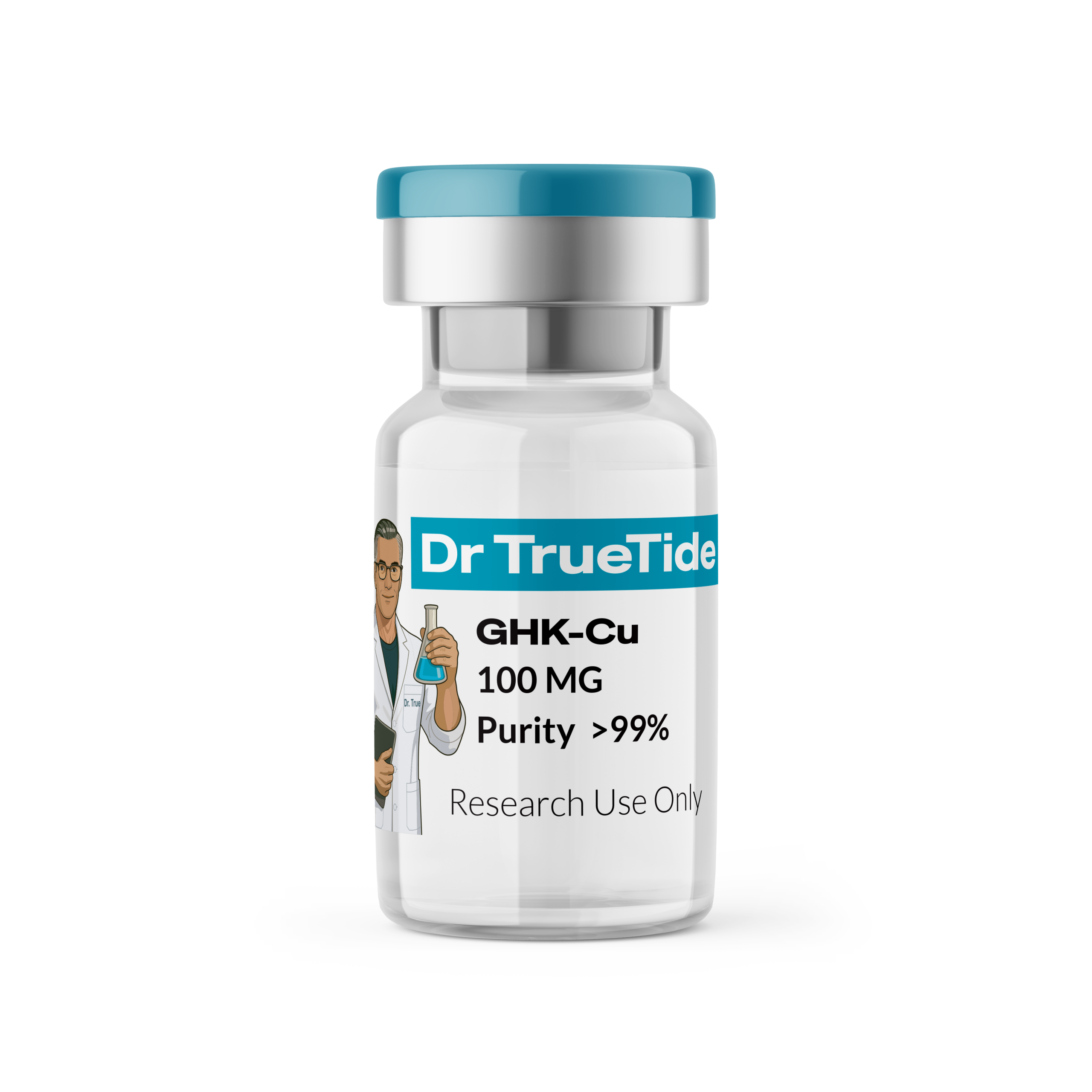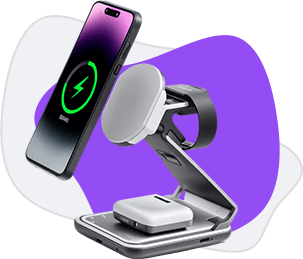GLOW
$185.00
Note: Peptides will arrive in a lyophilized (powder) form for maximum stability.
GLOW is a next-generation regenerative peptide formulation combining GHK-Cu (55 mg), TB‑500 (12 mg), and BPC‑157 (10 mg)—three of the most well-researched therapeutic peptides in the field of anti-aging and tissue regeneration. Together, they work synergistically to stimulate collagen production, accelerate wound healing, promote hair and skin rejuvenation, support vascular and nerve repair, reduce inflammation, and counteract fibrosis. By activating complementary cellular repair pathways, GLOW offers a multi-layered approach to longevity, helping the body maintain structural integrity, regenerate youthful function, and recover more effectively from age-related degeneration¹.
Need Help? Chat with an Expert
Money Back Guarantee
Free Shipping & Returns
Online Support 24/7
Secure Payment
Product Details
- Chemical Identity and Properties
- Primary Uses and Effects
- Notable Scientific Studies
- Emerging and Future Research Directions
- Sources
- Disclaimer
1. Chemical Identity and Properties
GLOW is a lyophilized tri-peptide blend formulated for research and injectable therapeutic use, containing:
GHK-Cu – 55 mg (Copper Tripeptide-1)
- CAS Number: 89030-95-5
- Molecular Formula: C₁₄H₂₂CuN₆O₄
- Molar Mass: 403.90 g/mol
- Sequence: Gly-His-Lys
- PubChem CID: 16219496
TB-500 – 12 mg (Synthetic thymosin beta-4 fragment)
- CAS Number: 77591-33-4
- Molecular Formula: C₂₁₂H₃₄₀N₅₆O₇₈S
- Molar Mass: ~4963 g/mol
- PubChem CID: 16129629
BPC-157 – 10 mg (Body Protection Compound-157)
- CAS Number: 137525-51-0
- Molecular Formula: C₆₂H₉₈N₁₆O₂₂
- Molar Mass: 1419.55 g/mol
- Sequence: Gly-Glu-Pro-Pro-Pro-Gly-Lys-Pro-Ala-Asp-Asp-Ala-Gly-Leu-Val
- PubChem CID: 9941957
2. Primary Uses and Effects
Skin Rejuvenation and Anti-Aging
GLOW promotes skin renewal by increasing the production of collagen, elastin, and other structural proteins. GHK-Cu enhances fibroblast activity and activates over 4,000 genes linked to tissue regeneration and repair². It has been shown to tighten sagging skin, reduce fine lines, and improve skin thickness and texture³. TB‑500 contributes by increasing vascularization and keratinocyte migration, while BPC‑157 accelerates wound closure and epithelialization, even in burn or chronic wounds⁴. Together, these peptides provide deep structural rejuvenation from the dermis outward, reducing signs of aging and restoring a youthful skin profile⁵.
Wound Healing and Tissue Regeneration
Each component of GLOW contributes to efficient healing across skin, muscle, tendon, and connective tissue. GHK-Cu modulates metalloproteinase activity, preventing excessive scar formation while promoting organized collagen deposition⁶. TB‑500 accelerates recovery from muscle and tendon injuries by increasing actin polymerization and enhancing angiogenesis⁷. BPC‑157 further enhances repair by stimulating VEGF receptor signaling, promoting granulation tissue formation, and increasing fibroblast proliferation, even under inflammatory or ischemic conditions⁸. When combined, these peptides cover all stages of healing: from inflammation resolution to tissue remodeling, shortening recovery time and improving repair quality.
Anti-Inflammatory and Anti-Fibrotic Effects
GLOW creates a systemically anti-inflammatory environment by downregulating cytokines like TNF-α and IL-6⁹. GHK-Cu reduces inflammatory signaling in dermal and endothelial cells¹⁰. TB‑500 suppresses NF-κB activation, limiting chronic inflammation at the site of injury¹¹. BPC‑157 adds systemic antioxidant protection and reduces oxidative stress via upregulation of SOD and HO-1, preventing cellular damage¹². These peptides also reduce fibrosis and adhesion formation by modulating TGF-β, collagen synthesis, and MMP balance—resulting in “cleaner,” more functional healing¹³.
Muscle, Nerve, and Vascular Regeneration
TB‑500 and BPC‑157 both promote muscle fiber regeneration and have been shown to restore function after trauma or ischemic injury¹⁴. GHK-Cu indirectly supports this through blood vessel formation and antioxidant support. In the nervous system, TB‑500 has shown protective effects in models of brain trauma and stroke, reducing apoptosis and inflammation¹⁵. BPC‑157 has demonstrated remarkable healing in severed peripheral nerves and even spinal cord injury in preclinical studies¹⁶. All three peptides promote angiogenesis through VEGF pathways, enhancing oxygen and nutrient delivery to tissues, which is essential for both repair and long-term tissue vitality¹⁷.
3. Notable Scientific Studies
GHK-Cu Clinical Trial (Lupo et al., 2005): In a 12-week study on women with photodamaged skin, topical GHK-Cu significantly increased collagen, improved elasticity, reduced fine lines, and enhanced dermal density. It outperformed both retinoic acid and vitamin C in restoring youthful skin appearance²².
TB‑500 Cardiac Regeneration (Bock-Marquette et al., 2004): In rodent heart attack models, thymosin β4 reduced infarct size, increased capillary formation, and improved heart function. Follow-up human trials confirmed reduced scar tissue and improved ejection fraction in post-MI patients¹⁸.
BPC‑157 Wound Healing (Sikiric et al., 2020): In rodent models of full-thickness burns and tendon ruptures, BPC‑157 accelerated closure, promoted collagen alignment, and restored strength faster than standard treatments. It also reduced systemic inflammation and oxidative damage¹⁹.
Synergistic Inference: Though not studied together in one trial, the individual research shows that GHK-Cu, TB‑500, and BPC‑157 operate through complementary mechanisms. GHK-Cu activates gene repair and skin remodeling; TB‑500 recruits progenitor cells and enhances cytoskeletal repair; BPC‑157 triggers vascular regeneration and systemic tissue protection. Together, they support multi-system rejuvenation and high-quality healing across skin, connective tissue, muscle, nerves, and vasculature²⁰.
4. Emerging and Future Research Directions
Longevity and Whole-Body Regeneration
GHK-Cu modulates gene expression to resemble youthful patterns—activating genes involved in DNA repair, stem cell survival, and collagen production². TB‑500 improves tissue elasticity and cardiac regeneration. BPC‑157 restores microvascular health, reduces fibrosis, and protects neural pathways. Together, they may slow the cellular aging process, improve organ recovery, and support whole-body functional longevity²¹.
Neuroregenerative Applications
TB‑500 and BPC‑157 are being tested in models of spinal cord injury, stroke, and neurodegeneration, where they reduce inflammation, preserve neurons, and restore movement. Combining their effects with GHK-Cu’s anti-inflammatory and vascular support may create a peptide-based neuroprotective platform with applications in brain aging and recovery.
Anti-Fibrosis and Organ Health
All three peptides show promise in preventing fibrotic progression in liver, lung, and cardiac tissue. Studies show reductions in TGF-β activity, collagen overproduction, and improved remodeling after chronic inflammation²³. In the future, peptides like GLOW may serve as non-hormonal tools for reversing fibrosis and improving resilience in organs affected by metabolic or autoimmune diseases.
Advanced Delivery Systems
Researchers are exploring liposomal carriers, injectable depot systems, and oral BPC-157 for broader access and longer systemic effects. GHK-Cu and TB-500 have shown efficacy in injectable and topical applications, while oral BPC-157 may support gut-liver regeneration and systemic inflammation control. New delivery tech may extend peptide half-life and improve tissue targeting.
5. Sources
- Pickart L, Vasquez-Soltero JM. GHK Peptide as a Natural Modulator of Multiple Cellular Pathways in Skin Regeneration. Biomed Res Int. 2015.
- Maquart FX, et al. Stimulation of collagen synthesis in fibroblast cultures by GHK-Cu. FEBS Lett. 1988;238(2):343–346.
- Sosne G, et al. Thymosin β4 promotes epithelial migration and wound healing. Curr Med Chem. 2002.
- Seiwerth S, et al. BPC-157 and skin re-epithelialization. Wound Repair Regen. 2018;26(5):551–559.
- Pickart L, Margolina A. GHK-Cu and matrix remodeling enzymes. Int J Mol Sci. 2018;19(7):1987.
- Sosne G, Kleinman HK. Thymosin β4 and actin polymerization in healing. Ann N Y Acad Sci. 2007;1112:61–67.
- Sikiric P, et al. BPC-157 and complex soft tissue repair. J Physiol Pharmacol. 2020;71(5):719–726.
- Pickart L, et al. GHK-Cu as a TNF-alpha suppressor in skin inflammation. Exp Dermatol. 2017.
- Xing Y, et al. Thymosin β4 and NF-kB suppression. Front Pharmacol. 2021;12:767785.
- Bock-Marquette I, et al. Thymosin β4 activates cardiac repair. Nature. 2004;432:466–472.
- Canapp SO Jr, et al. TB-500 in tendon healing and performance recovery. Vet Surg. 2003.
- Vukojevic J, et al. BPC-157 and peripheral nerve regeneration. Neural Regen Res. 2021;17(3):482–487.
- Goldstein AL, et al. Thymosin β4 in multiple sclerosis and neuroprotection. Autoimmun Rev. 2020.
- Majewska M, et al. BPC-157 in spinal cord injury and systemic protection. Pol J Vet Sci. 2022.
- Jóźwiak M, et al. Medical applications and synergistic potential of BPC-157, GHK-Cu, and TB-500. Pharmaceuticals. 2024;18(2):185.
- Pickart L. GHK-Cu and age-associated gene expression changes. J Biomater Sci Polym Ed. 2015.
- McCormack CJ, et al. Copper peptide complexes accelerate healing. Wound Repair Regen. 2001;9(6):396–403.
- Badakhshi H, et al. Thymosin β4 gel in chronic ulcer patients. J Wound Care. 2020.
- Sikiric P, et al. BPC-157 overview in systemic healing and organ protection. Curr Pharm Des. 2018.
- Pickart L, Margolina A. GHK-Cu in skin biology and longevity. Int J Mol Sci. 2021.
- Pickart L, Margolina A. GHK-Cu and gene reprogramming. OBM Neurobiology. 2022.
- Lupo MP, et al. Clinical improvement in photodamaged skin with GHK-Cu cream. Dermatol Surg. 2005;31:S816–S819.
- Yoon JH, et al. TB-500 and BPC-157 in liver and lung fibrosis. Clin Exp Pharmacol Physiol. 2023.
6. Disclaimer
GLOW is for research use only. It is not approved by the FDA or any regulatory agency for human or veterinary use, consumption, or therapeutic applications of any kind. By purchasing this product, you agree to our Terms and Conditions.
Only logged in customers who have purchased this product may leave a review.
No Minimum Purchase - Free Shipping On All Orders -
GLOW
$185.00








Reviews
There are no reviews yet.